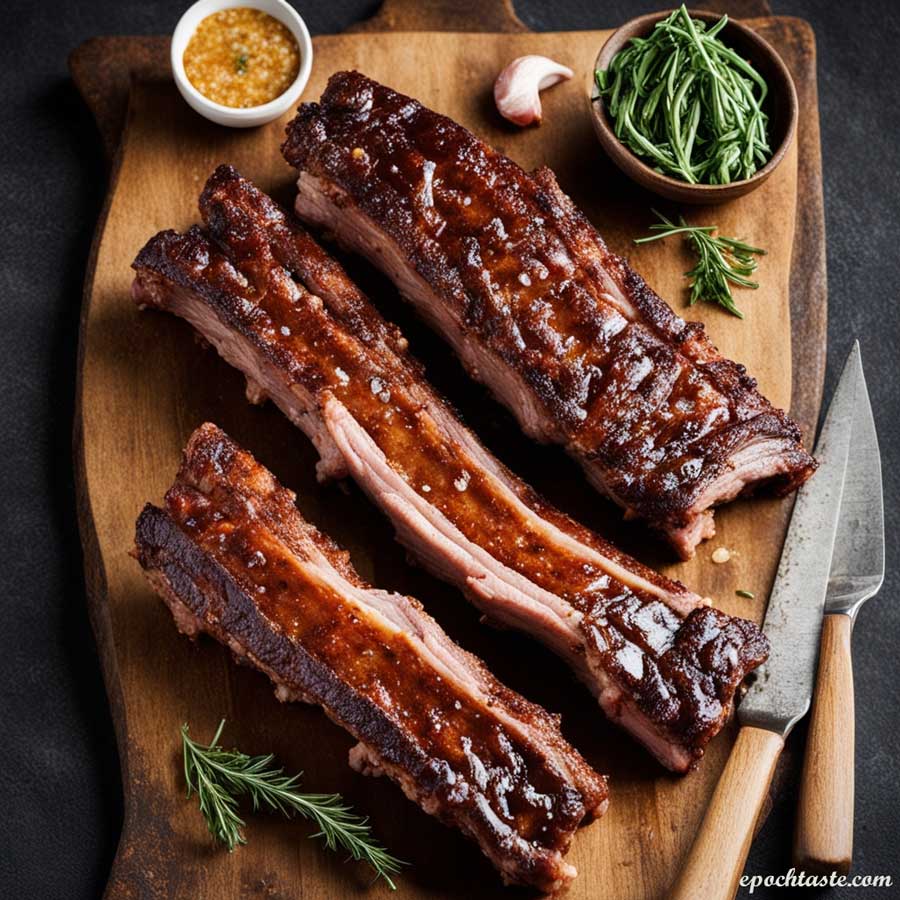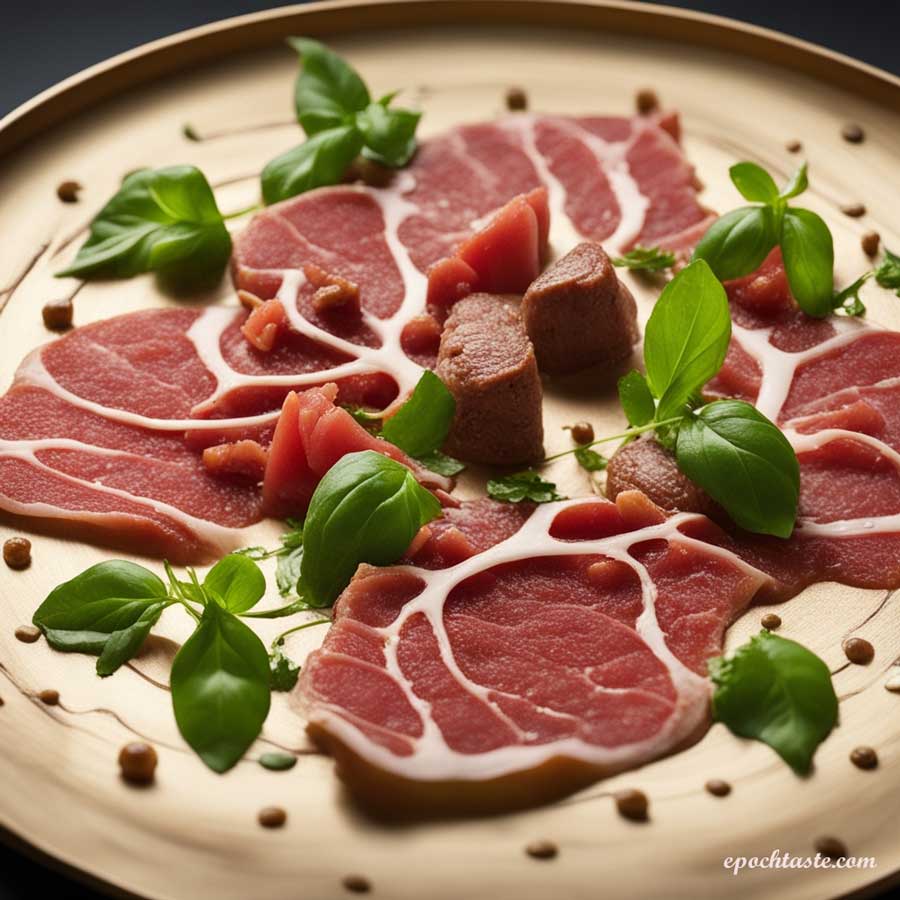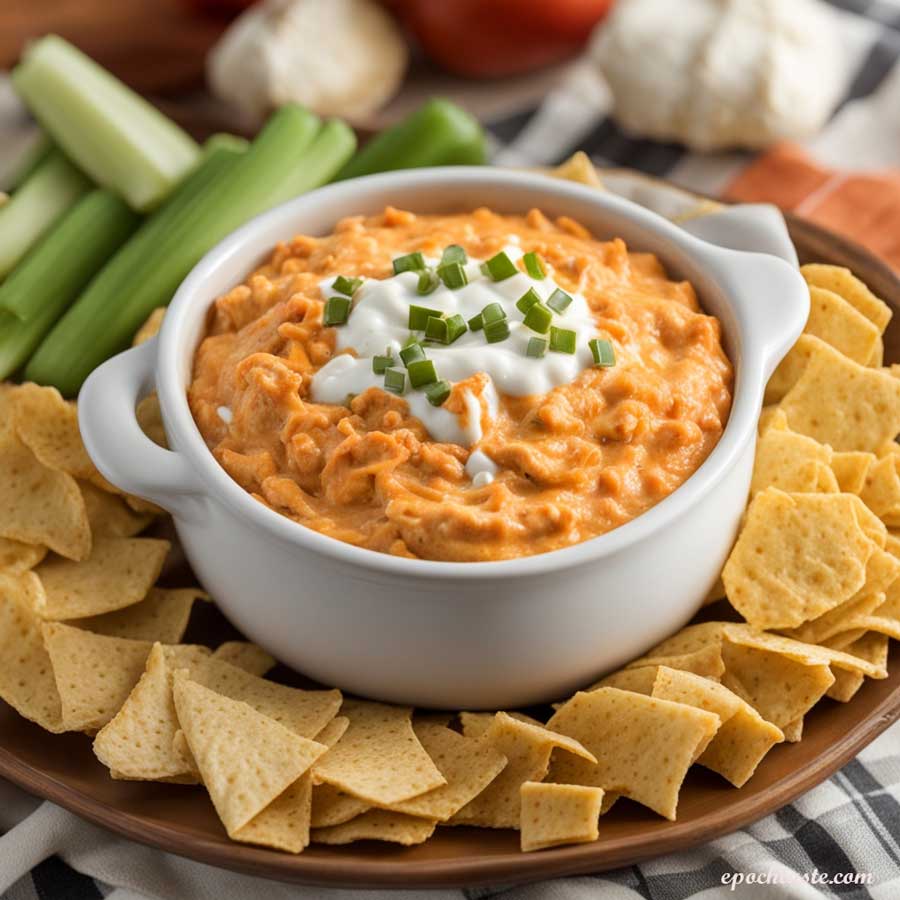Pork ribs are a beloved dish with worldwide acclaim, and for good reason. Their succulence, tenderness, and ability to absorb diverse flavors make them a culinary delight. Whether you’re a seasoned cook or a novice in the kitchen, this comprehensive guide will teach you how to cook pork ribs to perfection. From oven-baked classics to Chinese-inspired creations, slow-cooker wonders to delectable marinades, we’ll cover it all. So, prepare your taste buds for an unforgettable journey into the world of pork ribs.
Table of Contents
- Pork Ribs 101: Types and Cuts
- The Basics of Preparing Pork Ribs
- Mastering the Oven: How to Cook Pork Ribs
- A Taste of China: Chinese Pork Ribs Recipe
- Unlocking Flavor: Pork Ribs Marinades
- Slow and Steady Wins the Race: Slow Cooker Pork Ribs
- Jamie Oliver’s Signature: Pork Ribs Recipe
- Marinade Magic: Perfecting Ribs in the Oven
- Slow Cook Ribs in the Oven at 200°F: A Low and Slow Approach
- Conclusion: Savoring the Pork Rib Experience

Chapter 1: Pork Ribs 101: Types and Cuts
To become a pork rib maestro, you must start with the basics. We’ll explore the types and cuts of pork ribs available, each with its unique flavor and characteristics. Understanding your options is the first step toward mastering your rib-cooking journey.
Chapter 2: The Basics of Preparing Pork Ribs
Before we dive into cooking techniques, we’ll cover the fundamental steps in preparing pork ribs. From selecting the right ribs and removing the membrane to trimming excess fat and applying seasonings, this chapter will set the stage for mouthwatering results.
Chapter 3: Mastering the Oven: How to Cook Pork Ribs
We’ll explore the oven as a primary cooking tool for pork ribs. You’ll learn how to create tender, flavorful ribs through baking, and we’ll delve into essential factors like temperature, timing, and using foil or not.
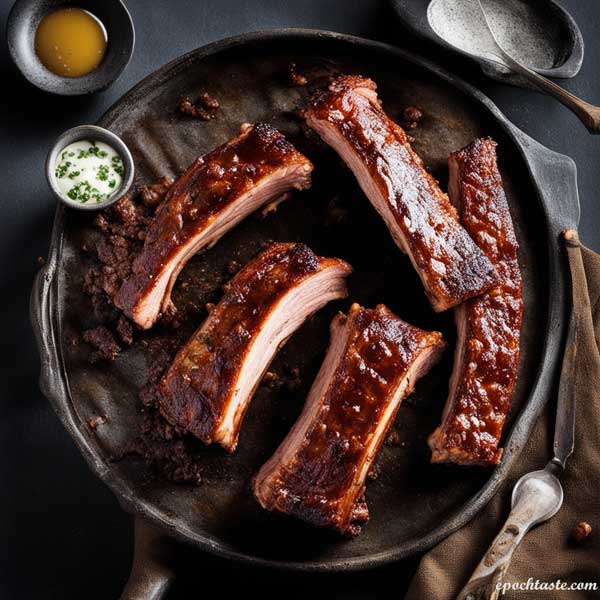
Chapter 4: A Taste of China: Chinese Pork Ribs Recipe
Embark on a flavorful journey to China with a delectable Chinese pork ribs recipe. Discover the secrets behind creating tender, aromatic ribs infused with the distinct flavors of Chinese cuisine.
Chapter 5: Unlocking Flavor: Pork Ribs Marinades
Pork ribs are fantastic canvas for flavors. In this chapter, we’ll explore a variety of marinades, from classic BBQ to exotic Asian-inspired concoctions, helping you elevate your pork ribs to the next level.
Chapter 6: Slow and Steady Wins the Race: Slow Cooker Pork Ribs
Slow cookers are perfect for busy days. This chapter covers the art of slow-cooking pork ribs, ensuring they turn out tender and mouthwateringly delicious.
Chapter 7: Jamie Oliver’s Signature: Pork Ribs Recipe
Explore a signature pork ribs recipe by the renowned chef Jamie Oliver. Learn the tips and tricks that make this dish so spectacular.
Chapter 8: Marinade Magic: Perfecting Ribs in the Oven
Delve into the world of marinated pork ribs, focusing on how to marinate them for oven cooking. From preparation to cooking, this chapter offers a step-by-step guide.
Chapter 9: Slow Cook Ribs in the Oven at 200°F: A Low and Slow Approach
For those who appreciate low and slow cooking, we’ll explore a unique method of slow-cooking ribs in the oven at 200°F. Discover the exquisite tenderness this technique offers.

Chapter 10: Conclusion: Savoring the Pork Rib Experience
In this final chapter, we’ll summarize the essential takeaways from our journey into the world of pork ribs. You’ll be ready to impress your friends and family with your newfound mastery of this delectable dish.
Now, let’s dive into each of these chapters, unlocking the secrets of cooking pork ribs and savoring the flavors.
Chapter 1: Pork Ribs 101: Types and Cuts
To begin your journey into the world of pork ribs, it’s crucial to understand the basic types and cuts available. Pork ribs come in several varieties, each with its unique attributes and flavors. The primary types of pork ribs include:
1. Baby Back Ribs: These ribs come from the upper part of the pig’s ribcage, closest to the spine. They are shorter and more curved, which makes them tender and lean. Baby back ribs are often regarded as the most tender and popular type.
2. Spare Ribs: Spare ribs are cut from the lower portion of the pig’s ribcage. They are meatier and larger than baby back ribs and have a higher fat content, making them more flavorful.
3. St. Louis-Style Ribs: These ribs are a specific cut of spare ribs with the brisket bone removed. This trimming creates a more uniform, rectangular shape, which makes them ideal for grilling and smoking.
4. Country-Style Ribs: Technically, these aren’t “ribs” in the traditional sense, but they are a popular choice for their meatiness. Country-style ribs come from the blade end of the loin, and they contain both meat and a portion of the shoulder bone.
5. Spareribs: Spareribs, or just “sides,” are larger and less meaty than baby back ribs. They are typically used for making spare rib recipes and are often seen in Asian cuisine.
Understanding the type and cut of ribs you’re working with is crucial when it comes to selecting the right cooking method and flavorings. Baby back ribs are ideal for those who prefer lean, tender ribs, while spare ribs and St. Louis-style ribs are great for those who enjoy richer, more flavorful meat.
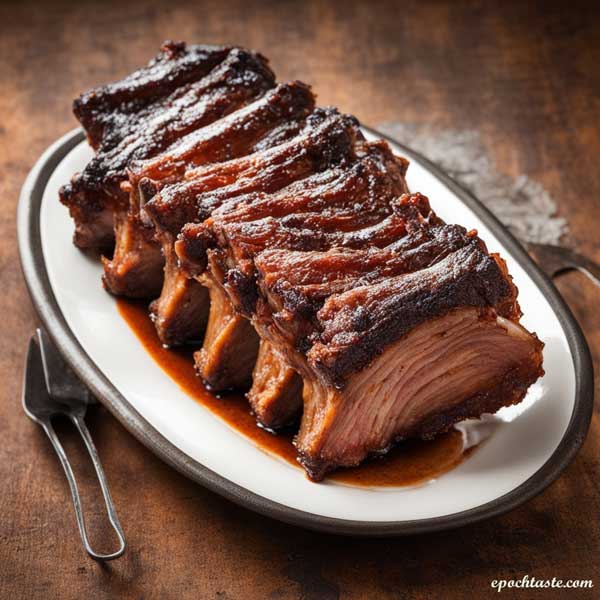
Chapter 2: The Basics of Preparing Pork Ribs
Before you begin cooking pork ribs, there are several essential preparation steps to ensure a delicious end result. Let’s go through these crucial steps:
1. Selecting Ribs: Choose your preferred type and cut of ribs based on your taste preferences. Be it baby back ribs for tenderness or spare ribs for extra flavor, the choice is yours.
2. Trimming Excess Fat: It’s essential to trim any excessive fat from the ribs. While some fat is necessary for flavor, too much can make your ribs greasy.
3. Removing the Membrane: On the bone side of the ribs, there’s a thin membrane. Removing this membrane is crucial as it can become tough during cooking and hinder the absorption of flavors. Use a butter knife or a paper towel to help you grip it, then peel it off.
4. Seasoning: Season the ribs with your preferred dry rub or marinade. A dry rub typically consists of a mixture of herbs, spices, salt, and sugar. Apply the rub generously on both sides, ensuring the meat is well-coated. For a more intense flavor, you can marinate the ribs for several hours or overnight in the refrigerator.
5. Resting: After seasoning, let the ribs rest at room temperature for about 30 minutes. This allows the seasonings to penetrate the meat, resulting in more flavorful ribs.
Proper preparation is the foundation for mouthwatering pork ribs. Now that your ribs are expertly prepped, it’s time to explore the techniques for cooking them to perfection.
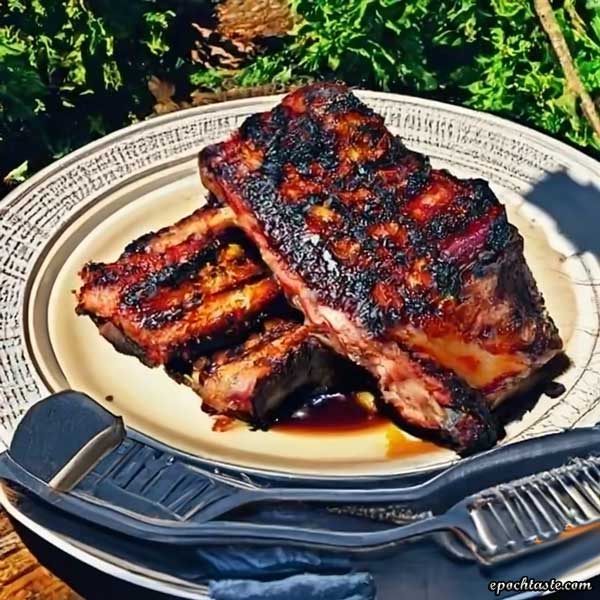
Chapter 3: Mastering the Oven: How to Cook Pork Ribs
The oven is a fantastic tool for cooking pork ribs. It offers a controlled and even cooking environment, resulting in tender, flavorful ribs. Here’s an overview of the steps to master oven-cooked pork ribs:
1. Preheat Your Oven: Start by preheating your oven to the desired temperature, which typically ranges from 275°F to 325°F (135°C to 163°C).
2. Use the Right Pan: Choose a baking dish or tray that’s large enough to accommodate the ribs without crowding. You can line the pan with aluminum foil for easy cleanup.
3. Foil or No Foil: The use of aluminum foil is a topic we’ll delve into more deeply in Chapter 8. It’s essential to decide whether you want to use foil or not based on your preferences.
4. Bake Until Tender: The key to oven-cooked pork ribs is to bake them until they are tender and the meat pulls away from the bone easily. This typically takes around 2 to 2.5 hours.
5. Sauce or Glaze: If you enjoy saucy or glazed ribs, apply your preferred sauce or glaze during the last 20-30 minutes of cooking. Be sure to baste the ribs a couple of times for a flavorful finish.
6. Rest and Serve: After cooking, let the ribs rest for a few minutes before slicing and serving. This allows the juices to redistribute within the meat, keeping it moist and flavorful.
Oven cooking is an excellent choice for those who prefer a controlled and even cooking environment, and it’s perfect for adding your favorite sauce or glaze.
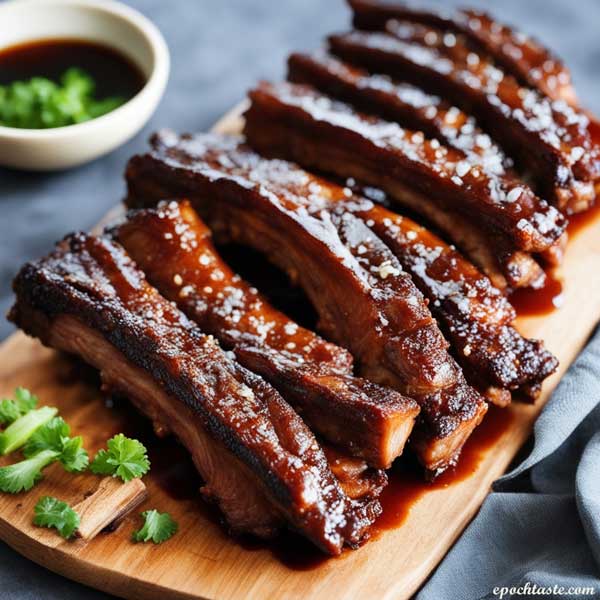
Chapter 4: A Taste of China: Chinese Pork Ribs Recipe
Experience the rich flavors of Chinese cuisine with a mouthwatering Chinese pork ribs recipe. In this chapter, we’ll explore how to create tender, aromatic ribs infused with the distinct tastes of Chinese cooking. Get ready to add a unique twist to your pork rib repertoire.
Ingredients:
- 2 pounds of spare ribs, cut into individual ribs
- 2 tablespoons of soy sauce
- 2 tablespoons of hoisin sauce
- 1 tablespoon of oyster sauce
- 1 tablespoon of Shaoxing wine (or dry sherry)
- 2 teaspoons of sugar
- 1 teaspoon of five-spice powder
- 2 cloves of garlic, minced
- 1 teaspoon of ginger, minced
- 1 teaspoon of sesame oil
- Salt and pepper, to taste
- Chopped green onions and sesame seeds for garnish (optional)
Instructions:
- In a bowl, combine the soy sauce, hoisin sauce, oyster sauce, Shaoxing wine, sugar, five-spice powder, minced garlic, minced ginger, and sesame oil. Mix well to create the marinade.
- Place the spare ribs in a large ziplock bag or a shallow dish and pour the marinade over them. Seal the bag or cover the dish and marinate in the refrigerator for at least 2 hours, or ideally, overnight.
- Preheat your oven to 325°F (163°C).
- Line a baking sheet with aluminum foil and place a wire rack on top. Remove the ribs from the marinade and place them on the wire rack, allowing excess marinade to drip off.
- Bake the ribs in the preheated oven for 45 minutes to 1 hour, or until they are tender and have a beautiful caramelized glaze.
- Once done, remove the ribs from the oven and let them rest for a few minutes. Garnish with chopped green onions and sesame seeds, if desired.
- Serve your Chinese-style pork ribs and savor the delightful fusion of flavors.
This Chinese pork ribs recipe infuses your pork ribs with an enticing blend of Asian spices and sauces. It’s a fantastic way to add variety to your pork rib culinary adventures. In Chapter 5, we’ll explore how to create incredible marinades to enhance the flavor of your pork ribs.
Chapter 5: Unlocking Flavor: Pork Ribs Marinades
Marinades are the key to elevating the flavor of your pork ribs. Whether you prefer classic BBQ flavors, Asian-inspired sauces, or zesty citrus blends, this chapter will help you create mouthwatering marinades that will take your ribs to the next level. Here are a few marinade recipes to get you started:
Classic BBQ Marinade:
- 1/2 cup of ketchup
- 1/4 cup of brown sugar
- 1/4 cup of apple cider vinegar
- 2 tablespoons of Worcestershire sauce
- 1 tablespoon of Dijon mustard
- 1 teaspoon of smoked paprika
- 1/2 teaspoon of garlic powder
- Salt and pepper to taste
Asian-inspired Marinade:
- 1/4 cup of soy sauce
- 2 tablespoons of honey
- 2 tablespoons of hoisin sauce
- 1 tablespoon of sesame oil
- 2 cloves of garlic, minced
- 1 teaspoon of ginger, minced
Zesty Citrus Marinade:
- 1/4 cup of orange juice
- 1/4 cup of lime juice
- 1/4 cup of lemon juice
- 2 tablespoons of olive oil
- 2 cloves of garlic, minced
- 1 teaspoon of cumin
- 1/2 teaspoon of chili powder
- Salt and pepper to taste
Instructions:
- Combine the ingredients for your chosen marinade in a bowl and mix well.
- Place your trimmed and prepared ribs in a large ziplock bag or a shallow dish.
- Pour the marinade over the ribs, ensuring they are well-coated. Seal the bag or cover the dish and marinate in the refrigerator for at least 2 hours, or ideally, overnight.
- When you’re ready to cook the ribs, remove them from the marinade and let any excess marinade drip off.
- Follow your preferred cooking method, whether it’s in the oven, on the grill, or in the slow cooker, as discussed in this guide.
- Enjoy your marinated pork ribs with the added depth of flavor that only a marinade can provide.
Marinades are a fantastic way to infuse your pork ribs with unique and enticing flavors. Whether you’re a fan of traditional BBQ or desire an international twist, marinades are a versatile tool to enhance your culinary creations. In Chapter 6, we’ll explore a slow and steady approach with slow-cooker pork ribs.
Chapter 6: Slow and Steady Wins the Race: Slow Cooker Pork Ribs
Slow cookers are the epitome of convenience in the kitchen, and they work wonderfully for preparing tender and flavorful pork ribs. In this chapter, we’ll explore the art of slow-cooking pork ribs, ensuring they turn out succulent and delicious.
Ingredients:
- 2 pounds of pork ribs (baby back or spare ribs)
- 1 onion, sliced
- 2 cloves of garlic, minced
- 1 cup of BBQ sauce
- 1/4 cup of apple cider vinegar
- 1/4 cup of brown sugar
- 1 tablespoon of paprika
- Salt and pepper, to taste
Instructions:
- Begin by preparing the ribs as discussed in Chapter 2, which includes trimming, removing the membrane, and seasoning them with salt and pepper.
- In a slow cooker, layer the sliced onions and minced garlic at the bottom.
- Place the seasoned ribs on top of the onion and garlic bed.
- In a bowl, mix together the BBQ sauce, apple cider vinegar, brown sugar, and paprika. Pour this mixture over the ribs.
- Set your slow cooker to low heat and cook the ribs for 6-8 hours, or until they are tender and cooked through.
- Once the ribs are done, you can transfer them to a preheated grill or oven to give them a quick sear for that classic caramelized finish.
- Serve your slow cooker pork ribs with your preferred sides and enjoy the rich flavors.
Slow cooker pork ribs offer a convenient way to achieve tender and flavorful results. The slow-cooking process allows the meat to become incredibly succulent and fall-off-the-bone tender. If you’re looking for a change of pace and a Jamie Oliver signature recipe, Chapter 7 will have you covered.
Chapter 7: Jamie Oliver’s Signature: Pork Ribs Recipe
Jamie Oliver, the renowned chef, has his take on preparing delicious pork ribs. In this chapter, we’ll explore Jamie Oliver’s signature pork ribs recipe, complete with his unique flavor twists and cooking techniques.
Jamie Oliver’s Pork Ribs Recipe:
Ingredients:
- 2 racks of baby back ribs
- 4 cloves of garlic, minced
- 1 small bunch of fresh thyme, leaves picked
- 1 lemon, zest and juice
- Olive oil
- Salt and pepper, to taste
Instructions:
- Begin by preparing the ribs. Remove the membrane from the bone side, trim any excess fat, and season the ribs with salt and pepper.
- In a bowl, combine the minced garlic, thyme leaves, lemon zest, and a generous drizzle of olive oil. Mix to create a flavorful paste.
- Rub the garlic and thyme mixture over both sides of the ribs, ensuring they are well-coated. Allow the ribs to marinate for at least 30 minutes.
- Preheat your grill to medium-high heat. Place the ribs on the grill and cook for about 15 minutes on each side, or until they are tender and have a beautiful char.
- While grilling, baste the ribs with the lemon juice to add a zesty, citrusy flavor.
- Once done, remove the ribs from the grill and let them rest for a few minutes.
- Slice and serve your Jamie Oliver-inspired pork ribs, savoring the delightful combination of garlic, thyme, and lemon.
Jamie Oliver’s signature pork ribs recipe provides a fresh and zesty twist to this classic dish. The garlic, thyme, and lemon infusion adds a unique and irresistible flavor profile to your ribs. In Chapter 8, we’ll focus on marinades specifically tailored for oven cooking.
Chapter 8: Marinade Magic: Perfecting Ribs in the Oven
Marinades are an incredible tool to enhance the flavor of your pork ribs, especially when you’re planning to cook them in the oven. In this chapter, we’ll explore marinades that are perfect for oven cooking, ensuring that your ribs come out tender and packed with flavor.
Classic BBQ Marinade for Oven Cooking:
- 1/2 cup of ketchup
- 1/4 cup of brown sugar
- 1/4 cup of apple cider vinegar
- 2 tablespoons of Worcestershire sauce
- 1 tablespoon of Dijon mustard
- 1 teaspoon of smoked paprika
- 1/2 teaspoon of garlic powder
- Salt and pepper to taste
Instructions:
- Prepare your ribs as discussed in Chapter 2, including trimming, removing the membrane, and seasoning them with salt and pepper.
- In a bowl, combine the ingredients for the classic BBQ marinade. Mix well to create a flavorful sauce.
- Place the seasoned ribs in a large ziplock bag or a shallow dish.
- Pour the marinade over the ribs, ensuring they are well-coated. Seal the bag or cover the dish and marinate in the refrigerator for at least 2 hours, or ideally, overnight.
- When you’re ready to cook the ribs in the oven, remove them from the marinade and let any excess marinade drip off.
- Follow the oven-cooking steps outlined in Chapter 3 to bake your ribs to perfection.
- Serve your marinated pork ribs and savor the enhanced flavor.
Marinades specifically designed for oven cooking are excellent for infusing your ribs with flavor. The combination of ingredients in the classic BBQ marinade provides a rich and savory profile that complements oven cooking beautifully. If you prefer a slow and low approach, Chapter 9 will guide you through slow-cooking ribs in the oven at 200°F.
Chapter 9: Slow Cook Ribs in the Oven at 200°F: A Low and Slow Approach
For those who appreciate the magic of low and slow cooking, we’ll explore a unique method of slow-cooking ribs in the oven at 200°F (93°C). This technique ensures exquisite tenderness and flavor that’s worth the extra time and patience.
Ingredients:
- 2 racks of baby back ribs
- 2 tablespoons of your preferred dry rub
- 1 cup of apple juice
Instructions:
- Begin by preparing the ribs, which includes removing the membrane, trimming excess fat, and seasoning the ribs with your chosen dry rub.
- Preheat your oven to 200°F (93°C).
- Place the seasoned ribs on a large baking sheet and cover them with aluminum foil.
- Bake the ribs in the preheated oven for 6-7 hours, or until they are exceptionally tender.
- About halfway through the cooking time, add the apple juice to the baking sheet to help keep the ribs moist and infuse them with a subtle fruity flavor.
- Once the ribs are done, you can finish them on the grill for a few minutes to create a charred, caramelized exterior.
- Slice and serve your slow-cooked ribs, savoring their extraordinary tenderness and flavor.
Cooking ribs in the oven at 200°F is a labor of love, and the result is incredibly tender, fall-off-the-bone meat that’s worth every minute of slow cooking. This low and slow approach is perfect for those special occasions when you want to impress your guests with unforgettable ribs.
Chapter 10: Conclusion: Savoring the Pork Rib Experience
Congratulations! You’ve completed your journey into the world of cooking pork ribs, and you’re now well-equipped to create mouthwatering, flavorful ribs that will leave a lasting impression. Whether you prefer the oven, slow cooker, or grill, have a penchant for classic BBQ flavors or want to explore international cuisines, this guide has provided you with the knowledge and techniques to master the art of pork rib cooking.
Remember to prepare your ribs correctly, select the right type and cut, and choose your cooking method based on your preferences. Season your ribs with a dry rub or marinate them to elevate their flavor. Whether you opt for low and slow cooking, grill them to perfection, or bake them in the oven, the end result will be a plate of delectable pork ribs that will tantalize your taste buds.
Now, it’s time to put your newfound expertise to use. Fire up your grill, preheat your oven, or set your slow cooker, and embark on a flavorful journey into the world of pork ribs. Prepare to indulge in the rich, savory goodness of this classic dish, and savor every succulent bite. Your taste buds will thank you for it.
Conclusion
In this comprehensive guide, we’ve explored the art of cooking pork ribs, covering a wide range of techniques and recipes. Whether you prefer oven-baked classics, Chinese-inspired creations, slow-cooker wonders, or delicious marinades, you’re now well-prepared to create delectable pork rib dishes that will leave your guests craving for more.
So, get ready to impress your friends and family with your newfound mastery of this beloved dish. Fire up your grill, preheat your oven, or set your slow cooker, and embark on a flavorful journey into the world of pork ribs. Enjoy the rich, savory goodness of this classic dish, and savor every mouthwatering bite. Happy cooking!

